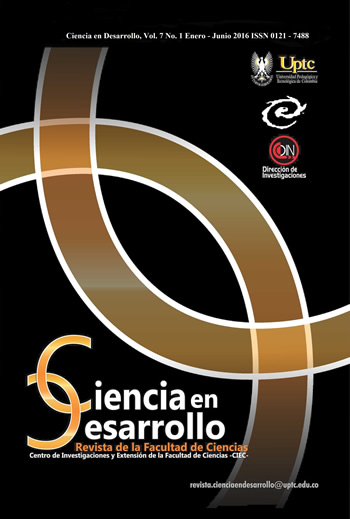Ga Concentration Effect on the CuIn1-xGaxSe2 Electronic Properties

Abstract
This paper reports some calculations of the electronic properties of CuIn1-xGaxSe2 (x = 0.0, 0.2, 0.4, 0.6, 0.8, 1.0) compound, by using the Tight-Binding (TB) method and Virtual Crystal Approximation (VCA). It is considered the ideal case and with the tetragonal () and anionic () distortions. In both cases, the CuIn1-xGaxSe2 is a direct semiconductor at Γ, for all concentrations.It was found that the Crystal Field Splitting (CFS) at the Γ point depends mainly on the tetragonal distortion. The CFS is positive for x <, 0,32 and negative for x >, 0.32. This behavior is due that when x is increasing, the unit cell shrinks, approaching the pseudo-atom (In,Ga) to the Se atom.
Keywords
CuIn1−xGaxSe2, Tight-Binding, aproximación de cristal virtual, Crystal Field Splitting. (CuIn1-xGaxSe2, Virtual Crystal Approximation, Crystal Field Splitting)
References
- J. Hedstrom, H. Ohlsen, M. Bodegard, A. Kylner, L. Stolt, D. Hariskos, M. Ruckh, and W. Schock, “ZnO/CdS/Cu(In,Ga)Se2 thin film solar cells with improved performance”, in Proceedings of the 23rd IEEE Photovoltaic Specialists Conference, pp. 364-371, May 1993.
- M. Contreras, B. Egaas, K. Ramanathan, J. Hiltner, A. Swartzlander, F. Hasoon, and R. Noufi, “Progress toward 20% eciency in Cu(In,Ga)Se2 polycrystalline thin-film solar cells”, Prog. Photovolt: Res. Appl., vol. 7, pp. 311-316, August 1999. DOI: https://doi.org/10.1002/(SICI)1099-159X(199907/08)7:4<311::AID-PIP274>3.0.CO;2-G
- M. Contreras, A. M. Gabor, A. L. Tenant, S. Asher, J. Tuttle, and R. Noufi, “Accelerated publication 16.4% total-area conversion
- eciency thin-film polycrystalline MgF2/ZnO/CdS/Cu(In,Ga)Se2/Mo solar cell”, Prog. Photovolt: Res. Appl., vol. 2, pp. 287-292, DOI: https://doi.org/10.1002/pip.4670020404
- October 1994.
- J. R. Tuttle, M. A. Contreras, A. M. Gabor, K. R. Ramanathan, A. L.Tennant, D. S. Albin, J. Keane, and R. Noufi, “Perspective on High-efficiency Cu(In, Ga)Se2-based Thin-film Solar Cells Fabricated by Simple, Scalable Processes”, Prog. Photovolt: Res. Appl., vol. 3, DOI: https://doi.org/10.1002/pip.4670030603
- -391, November 1995.
- J. R. Tuttle, J. S. Ward, A. Duda, T. A. Berens, M. A. Contreras, K. R. Ramanathan, A. L. Tennant, J. Keane, E. D. Cole, K. Emery, and
- R. Nouri, “The Performance of Cu(In,Ga)Se2- Based Solar Cells in Conventional and Concentrator Applications”, Mater. Res. Soc. Symp.,
- vol. 426, 143-151, 1996.
- J. R. Tuttle, M. Contreras, A. Tennant, D. Albin, and R. Noufi, “High eciency thin-film Cu (In, Ga) Se2-based photovoltaic devices:
- progress towards a universal approach to absorber fabrication”, in Proceedings of the 23rd IEEE Photovoltaic Specialists Conference, pp.
- -421, May 1993.
- K. R. Ramanathan, M. A. Contreras, C. L. Perkins, S. Asher, F. S. Hasoon, J. Keane, D. Young, M. Romero, W. Metzger, R. Noufi, J.
- S. Ward, and A. Duda, “Properties of 19.2% efficiency ZnO/CdS/CuInGaSe2 thin-film solar cells”, Prog. Photovolt: Res. Appl., vol.11, pp. 225-230, June 2003. DOI: https://doi.org/10.1002/pip.494
- R. W. Birkmire, J. R. Sites, “Polycrystalline compound thin film devices: Laboratory cells to modules”, in: IEEE (Ed.), 28th IEEE PVSC
- (Photovoltaic Specialist Conference), IEEE, Anchorage, AK, USA, 2-11, 2000.
- T. Suárez, D. Rasero, R. Jiménez, and J. Arbey Rodríguez, “Cu(InGa)Se2: Un estudio de la estructura electrónica usando Tight-Binding, Aproximación de Cristal Virtual y Método de Montecarlo”, Rev. Col. Fis., vol. 41, pp. 268- 270, abril 2009.
- J. C. Slater, and G. F. Koster, “Simplified LCAO Method for the Periodic Potential Problem”, Phys. Rev., vol. 94, pp. 1498-1524, June DOI: https://doi.org/10.1103/PhysRev.94.1498
- F. A. P. Blom,“Determination of the Fermi Surface in CdSnAs using a Tight-Binding Model for Chalcopyrites”, Phys. Rev. B, vol. 32, pp. 2334-2336, August 1985. DOI: https://doi.org/10.1103/PhysRevB.32.2334
- J. A. Rodríguez, “Estructura de Bandas de las Calcopiritas basadas en Cobre”, Tesis doctoral, Departamento de Física, Universidad Nacional de Colombia, Ciudad Universitaria, Bogotá, D.
- C., 1999.
- J. A. Rodríguez, L. Quiroga, A. Camacho, and R. Baquero, “Electronic Band Structure of CuInSe2: Bulk and (112) surface”, Phys. Rev. B,, vol. 59, pp. 1555-1558, January 1999. DOI: https://doi.org/10.1103/PhysRevB.59.1555
- R. Hill, “Energy-gap Variations in Semiconductor Alloys”, J. Phys. C: Solid State Phys.,vol. 7, pp. 521-526, February 1974. DOI: https://doi.org/10.1088/0022-3719/7/3/009
- R. D. Olguín, “Estructura Electrónica de Compuestos Semiconductores Nuevos II-VI: Superficies y Heteroestructuras”, Tesis doctoral, Departamento de Física, Centro de Investigaciones
- y de Estudios Avanzados del IPN (CINVESTAV), México, D. F., México, 1996.
- J. Jae, A. Zunger, “Electronic Structure of the Ternary Chalcopyrite Semiconductors CuAlS2, CuGaS2, CuInS2, CuAlSe2, CuGaSe2, and CuInSe2”, Phys. Rev. B, vol. 28, pp. 5822-
- , November 1983.
- J. Jae, and A. Zunger, “Theory of the Bandgap Anomaly in ABC2 Chalcopyrite Semiconductors”, Phys. Rev. B, vol. 29, pp. 1882-1906,
- February 1984.